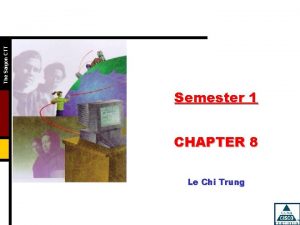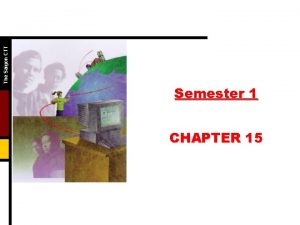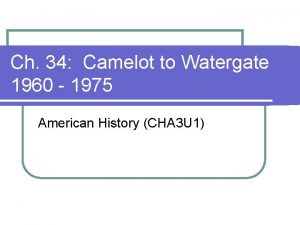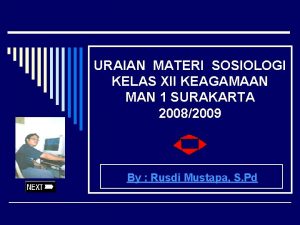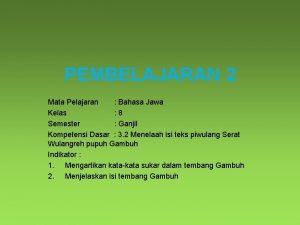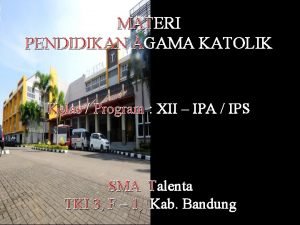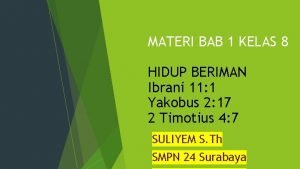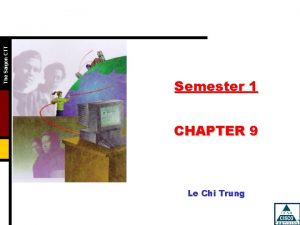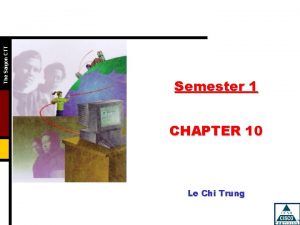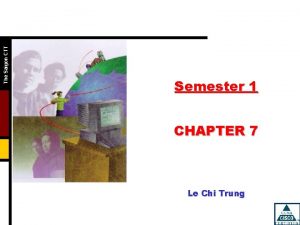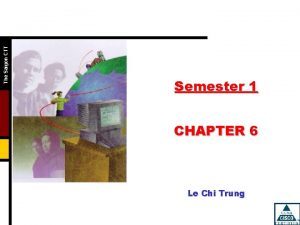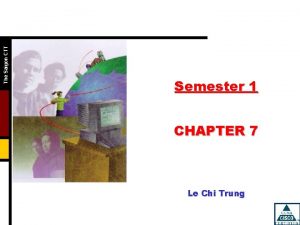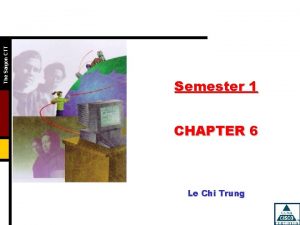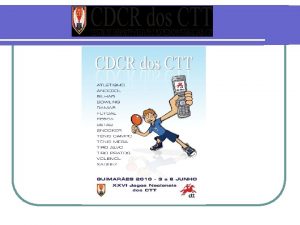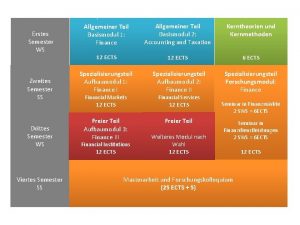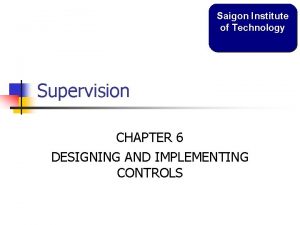The Saigon CTT Semester 1 CHAPTER 8 Le

























































































- Slides: 89

The Saigon CTT Semester 1 CHAPTER 8 Le Chi Trung

The Saigon CTT }Content • Network design and documentation. • Planning structured cabling. • Design practices. • Electricity and grounding. • Network power supply.

The Saigon CTT }Schedule Date Lesson No 27 -Aug 8. 1 Name Chapter 7 Online Exam Lab Est time No Name Est Time Basics network design and documentations 0: 20: 00 8. 2 Wiring closet specifications 0: 20: 00 8. 3 Identifying potential wiring closets 0: 20: 00 8. 4 Selection practice 29 -Aug 8. 5 Horizontal and backbone cabling 0: 30: 00 8. 6 Electricity and grounding 0: 15: 00 8. 7 Cabling and grounding 0: 15: 00 8. 8 A wiring plan for Ethernet star topology LAN 0: 15: 00 8. 9 Multiple earth ground problems 0: 15: 00 8. 10 Power line problems 0: 15: 00 8. 11 Surge suppressors and UPS functions 0: 15: 00 31 -Aug Chapter 8 Online Exam Homework

The Saigon CTT NETWORK DESIGN AND DOCUMENTATION

The Saigon CTT }General design process 1. Develop a Layer 1 LAN topology: – – The type of cable (fiber, coaxial, CAT 5 …). The physical (wiring) topology. Types of Ethernet topologies. Hub, repeater, closet, patch panel. . . 2. Develop a Layer 2 LAN topology: – To add Layer 2 devices to your topology to improve its capabilities. 3. Develop a Layer 3 LAN topology: – Build scalable inter-networks. – Link to WANs.

The Saigon CTT }Network design issues • Gather information about the organization. • Analyze and assess of the current and projected requirements. • Identify the resources and constraints of the organization. • Document the information in the framework of a format report.

The Saigon CTT }Network design process • Designer: person doing the design. • Client: person who has requested, and is probably paying for, the design. • Users: persons who will be using the product. • Brainstorming: generation of creative ideas for the design. • Specifications development: usually numbers which will measure how well the design works. • Building and testing: to meet client objectives and satisfy certain standards.

The Saigon CTT }General design methodology • Problem solving cycle. • Problem solving matrix. • Brainstorming.

The Saigon CTT }Problem solving cycle

The Saigon CTT }Problem solving matrix

The Saigon CTT }Brainstorming – Quantity of ideas. – No censorship of ideas. – Building upon others ideas. – Wildest ideas possible.

The Saigon CTT }Network design documents • Engineering journal. • Logical topology. • Physical topology. • Cut sheets. • Problem-solving matrices. • Labeled outlets. • Labeled cable runs. • Summary of outlets and cable runs. • Summary of devices, addresses.

The Saigon CTT }Review • Understand about design process. • Design documentation.

The Saigon CTT PLANNING STRUCTURED CABLING

The Saigon CTT }Cabling standard

The Saigon CTT }Cabling terminologies

The Saigon CTT }Horizontal cabling components

The Saigon CTT }Horizontal cabling structure

The Saigon CTT }Horizontal cables • 4 -pair 100 Ω UTP. • 2 fiber (duplex) 62. 5/125 µm or multimode optical fiber. • 50/125 µm multimode fiber will be allowed in ANSI/TIA/EIA-568 -B. • A minimum of two telecommunication outlets are required for each individual work area.

The Saigon CTT }Wiring closet: Overview

The Saigon CTT }Wiring closet: Specification • A central point of a star topology. • Where the horizontal cabling runs must be attached and the patch panel must be installed. • The size will vary with the size of the LAN and the types of equipment required to operate it: – Each floor must have a minimum of one wiring closet. – Each 1000 m 2 have a wiring closet.

The Saigon CTT }Wiring closet: Size

The Saigon CTT }Wiring closet: Environmental • Materials for walls, floors, and ceilings. • Temperature and humidity. • Locations and types of lighting. • Power outlets. • Room and equipment access. • Cable access and support.

The Saigon CTT }Wiring closet: Wall, floor and ceiling Rooms must not have a dropped, or false, ceiling 20 mm plywood that is at least 2. 4 m • Minimum load capacity. • Raised floor or Ladder Rack Support. • Tiled, or some other type of finished surface.

The Saigon CTT }Wiring closet: HVAC }Temperature : 21 OC }Relative humidity : 30% - 50% }HVAC : Heating/Ventilation/Air Conditioning No water or steam pipes running through or above the room.

The Saigon CTT }Wiring closet: Lighting and Power • Minimum of two dedicated, non-switched, AC duplex electrical outlet. • At least one duplex power outlet positioned every 1. 8 m along each wall. • Power outlet should be positioned 150 mm above the floor. • A lighting switch should be placed immediately inside the door. • Florescent lighting should be avoided for cable pathways.

The Saigon CTT }Wiring closet: Room and equipment Wiring hub and patch panel were mounted to a wall with a hinged wall bracket. Wiring hub and patch panel were mounted with distribution rack

The Saigon CTT }Wiring closet: Cable access Any wall/ceiling openings that provide access for the conduit. • All horizontal cabling that runs from work areas to a wiring closet should be run under a raised floor. • When this is not possible, the cabling should be run through 10. 2 cm sleeves that are placed above door level.

The Saigon CTT }Wiring closet: Identification • Draw a floor plan approximately to scale. • Identify the devices that will be connected to the network. • MDF is secure locations that are close to the POP. • Choose potential wiring closet locations. • Determining number of wiring closets.

The Saigon CTT }Wiring closet: Floor plan

The Saigon CTT }Wiring closet: Star topology Draw circles that represent a radius of 50 m from potential wiring closets.

The Saigon CTT }Wiring closet: Catchment area

The Saigon CTT }Wiring closet: Potential location (PW)

The Saigon CTT }Wiring closet: Identification PW • If there any potential wiring closet whose catchment areas substantially overlap, you could probably eliminate one of the wiring closet. • If there any potential wiring closet whose catchment areas can contain all of the devices that are to be connected to the network, then one of them could serve as the wiring closet for the entire.

The Saigon CTT }Wiring closet: Practice 1. 2. 3. 4. 5. 6. 7. 8. 9. Do any of the circles overlap? Can any of the PW locations be eliminated? Do any of the circles provide coverage for all of the devices that will be connected to the network? Which of the PW locations seems to be the best? Are there any circles where only a few of the devices fall outside the catchment area? Which PW is closest to the POP? Based on your findings, list the three best possible locations for wiring closets. Based on your findings, how many wiring closets do you believe will be required for this network? What are the advantages and disadvantages of each of the PW?

The Saigon CTT }Wiring closet: Practice (cont. )

The Saigon CTT }Wiring closet: Practice (PWs)

The Saigon CTT }Wiring closet: HOMEWORK • Teamwork: – 5 groups. • Object: – Identification wiring closets for floor plan. • Presentation: – 5 -10 minutes per group. • Tools: – Microsoft Visio, Microsoft Power. Point… • Feedback: – From other students.

The Saigon CTT }Multiple Wiring closet: MDF and IDF • MDF: Main distribution facility MDF: • IDF: Intermediate distribution facility. IDF:

The Saigon CTT }Multiple Wiring closet: Multi-story The MDF is usually located on one of the middle floors of the building, even though the POP might be located on the first floor, or in the basement.

The Saigon CTT }Backbone: Components • Backbone cabling runs. • Intermediate and main cross-connects. • Patch cords used for backbone-tobackbone cross-connections. – Vertical networking media between wiring closets on different floors. – Networking media between the MDF and the POP. – Networking media used between buildings in a multi-building campus.

The Saigon CTT }Backbone: Structure

The Saigon CTT }Backbone: Media • 100 Ω UTP (four-pair). • 150 Ω STP (two-pair). • 62. 5/125 µm multimode optical fiber. • Single-mode optical fiber. G Although TIA/EIA-568 -A recognizes 50Ω coaxial cable, generally, it is not recommended for new installations.

The Saigon CTT }Backbone: TIA/EIA-568 -A A. Each IDF can be connected directly to the main distribution facility. – IDF: horizontal cross-connect (HCC). – MDF: main cross-connect (MCC). B. 1 st IDF interconnected to a 2 nd IDF. The 2 nd IDF is then connected to the MDF. – 2 nd IDF: intermediate cross-connect (ICC). – No more than one ICC can be passed through to reach the MCC.

The Saigon CTT }Backbone: TIA/EIA-568 -A (type A)

The Saigon CTT }Backbone: TIA/EIA-568 -A (type B)

The Saigon CTT }Backbone: Maximum distance

The Saigon CTT }Backbone: Single mode FO (type A)

The Saigon CTT }Backbone: Single mode FO (type B)

The Saigon CTT }Review • What is a wiring closet and how to identify the wiring closets? • What is the backbone cabling? • What are HCC, ICC and MCC?

The Saigon CTT DESIGN PRACTICES

The Saigon CTT }Design 1: Overview 1. The campus has three buildings. 2. Each building is two stories tall. 3. The dimensions of the main building are 40 m. x 37 m. 4. The dimensions of both the east building and the west building are 40 m. x 23 m. 5. Each building has a different earth ground. 6. Each building has only a single earth ground. 7. All floors are covered with ceramic tile, unless otherwise specified.

The Saigon CTT }Design 1: Ethernet star topology

The Saigon CTT }Design 1: Main building

The Saigon CTT }Design 1: East building

The Saigon CTT }Design 1: West building

The Saigon CTT }Design 1: Your plan 1. Location of the MDF. 2. Location and number of IDFs. 3. Identity of IDFs used as HCCs. 4. Identity of IDFs used as ICCs. 5. Location of all backbone cabling runs between MDF and IDFs. 6. Location of any backbone cabling runs between IDFs. 7. Location of all horizontal cabling runs from IDFs to work areas.

The Saigon CTT }Design 1: Preparation • Teamwork: – 5 groups. • Presentation: – 10 minutes per group. • Tools: – Microsoft Visio, Microsoft Power. Point… • Feedback: – From other students.

The Saigon CTT }Design 2: Overview 1. The campus has three buildings. 2. Each building is two stories tall. 3. The dimensions of the main building are 40 m. x 37 m. 4. The dimensions of both the east building and the west building are 40 m. x 23 m. 5. Each building has a different earth ground. 6. Each building has only a single earth ground. 7. All floors are covered with ceramic tile, unless otherwise specified.

The Saigon CTT }Design 2: Multiple earth group

The Saigon CTT }Review • Present your solution for design 1.

The Saigon CTT ELECTRICITY AND GROUNDING

The Saigon CTT }AC and DC

The Saigon CTT }AC Line noise

The Saigon CTT }Electrostatic discharge (ESD) • Static electricity. • The most damaging and uncontrollable form of electricity. • ESD must be dealt with in order to protect sensitive electronic equipment. • ESDs can destroy semiconductors. • A solution that can help solve problems that arise from ESD is good grounding.

The Saigon CTT }Safety grounding • Third connector in power socket is called the safety ground connection. • The safety ground wire is connected to any exposed metal part of equipments. • The motherboards and computing circuits in computing equipment are electrically connected to the chassis, this also connects them to the safety grounding wire.

The Saigon CTT }Purpose of safety grounding • Be used to dissipate static electricity. • Prevent such metal parts from becoming energized with a hazardous voltage resulting from a wiring fault inside the device. • Whenever an electrical current is passed through this path into the ground, it causes protective devices such as circuit breakers to activate.

The Saigon CTT }Grounding wire

The Saigon CTT }Multi-ground connections • Large buildings frequently require more than one earth ground. • Separate earth grounds for each building are required in multi-building campuses. • When ground wires in separate locations have slightly different potential (voltage), to the common and hot wires, they can present a serious problem. • This errant potential voltage would have the ability to severely damage delicate computer memory chips.

The Saigon CTT }Network devices on separate building

The Saigon CTT }Dangerous circuit • Due to the ground wires for the devices in one location having a slightly different potential to both the common and hotwires than the ground wires for the devices in the second location. • Anyone touching the chassis of a device on the network would receive a nasty shock. • A good way to avoid having current pass through the body, and through the heart, is to use the one hand rule.

The Saigon CTT }Avoiding dangerous circuit • TIA/EIA-568 -A specifications for backbone cabling permit the use of fiber optic cable, as well as UTP cable. • When multiple buildings are to be networked, it is highly desirable to use fiber-optic cable as the backbone. • Whenever copper is used for backbone cabling, it can provide a pathway for lighting strikes to enter a building.

The Saigon CTT }Review • What are the purposes of safety grounding? • How to avoid dangerous circuit?

The Saigon CTT NETWORK POWER SUPPLY

The Saigon CTT }Power problem

The Saigon CTT }Normal mode and common mode • Normal mode problems do not, ordinarily, pose a hazard to you or to your computer. This is because they are usually intercepted by a computer's power supply, an uninterruptible power supply, or an AC power line filter. • Common mode problems, on the other hand, can go directly to a computer's chassis without an intervening filter. Therefore they can do more damage to data signals than normal mode problems. In addition, they are harder to detect.

The Saigon CTT }Power line problem: Total loss

The Saigon CTT }Power line problem: Sag and Surge

The Saigon CTT }Power line problem: Spike

The Saigon CTT }Power line problem: Noise

The Saigon CTT }Power problems damage • Lockups. • Loss of memory. • Problems in retrieving data. • Altered data. • Garbling. Protection products can save your data equipment from damage caused by direct contact with lightning, power lines, or electrostatic discharge.

The Saigon CTT }Protection solutions

The Saigon CTT }Surge protector • To protect the system equipment from surges introduced between the building entrance and the system equipment, install the inline surge protector between those two points and as close as possible to the equipment being protected. • To protect the system equipment from surges introduced between the system equipment and the work area, install the inline surge protector between those two points and as close as possible to the equipment being protected. • To protect the work area equipment that is connected to the Local Exchange Carrier (LEC), Campus Backbone Cabling or System Equipment. If the work area equipment operates over more than one-pair, install the inline surge protector as close as possible to the equipment being protected.

The Saigon CTT }Surge suppressor • Prevent surges and spikes from damaging the networking device. • A device called a metal oxide varistor (MOV) is most often used as this type of surge suppressor. • Protects the networking devices by redirecting excess voltages, that occur during spikes and surges, to a ground. • This type of surge suppressor has a limited lifetime. • This type of surge suppressor would not be the best choice for your network.

The Saigon CTT }Uninterruptible Power Supply • An uninterruptible power source is designed to handle only short-duration power outages. • If a LAN requires uninterrupted power, even during power outages that could last several hours, then a generator would be needed to supplement the backup provided by a UPS.

The Saigon CTT }UPS Components

The Saigon CTT }UPS Types

The Saigon CTT }Review • Power line problems. • The solutions for power problems. • Purposes of UPS.

The Saigon CTT
 Sai gon ctt
Sai gon ctt Mail saigonnewport
Mail saigonnewport Saigonctt
Saigonctt Saigon ctt
Saigon ctt Saigonctt
Saigonctt Saigon is gone poem
Saigon is gone poem Saigon palace
Saigon palace Zach anders
Zach anders Mai lai massacre primary sources
Mai lai massacre primary sources Saigon capital
Saigon capital Saigon 1975
Saigon 1975 Sai gon food
Sai gon food Saigon tech hcc
Saigon tech hcc Hát kết hợp bộ gõ cơ thể
Hát kết hợp bộ gõ cơ thể Ng-html
Ng-html Bổ thể
Bổ thể Tỉ lệ cơ thể trẻ em
Tỉ lệ cơ thể trẻ em Gấu đi như thế nào
Gấu đi như thế nào Tư thế worms-breton
Tư thế worms-breton Chúa yêu trần thế alleluia
Chúa yêu trần thế alleluia Các môn thể thao bắt đầu bằng tiếng đua
Các môn thể thao bắt đầu bằng tiếng đua Thế nào là hệ số cao nhất
Thế nào là hệ số cao nhất Các châu lục và đại dương trên thế giới
Các châu lục và đại dương trên thế giới Công thức tính thế năng
Công thức tính thế năng Trời xanh đây là của chúng ta thể thơ
Trời xanh đây là của chúng ta thể thơ Cách giải mật thư tọa độ
Cách giải mật thư tọa độ Làm thế nào để 102-1=99
Làm thế nào để 102-1=99 Phản ứng thế ankan
Phản ứng thế ankan Các châu lục và đại dương trên thế giới
Các châu lục và đại dương trên thế giới Thể thơ truyền thống
Thể thơ truyền thống Quá trình desamine hóa có thể tạo ra
Quá trình desamine hóa có thể tạo ra Một số thể thơ truyền thống
Một số thể thơ truyền thống Bàn tay mà dây bẩn
Bàn tay mà dây bẩn Vẽ hình chiếu vuông góc của vật thể sau
Vẽ hình chiếu vuông góc của vật thể sau Thế nào là sự mỏi cơ
Thế nào là sự mỏi cơ đặc điểm cơ thể của người tối cổ
đặc điểm cơ thể của người tối cổ Thế nào là giọng cùng tên? *
Thế nào là giọng cùng tên? * Vẽ hình chiếu đứng bằng cạnh của vật thể
Vẽ hình chiếu đứng bằng cạnh của vật thể Tia chieu sa te
Tia chieu sa te Thẻ vin
Thẻ vin đại từ thay thế
đại từ thay thế điện thế nghỉ
điện thế nghỉ Tư thế ngồi viết
Tư thế ngồi viết Diễn thế sinh thái là
Diễn thế sinh thái là Dot
Dot Bảng số nguyên tố lớn hơn 1000
Bảng số nguyên tố lớn hơn 1000 Tư thế ngồi viết
Tư thế ngồi viết Lời thề hippocrates
Lời thề hippocrates Thiếu nhi thế giới liên hoan
Thiếu nhi thế giới liên hoan ưu thế lai là gì
ưu thế lai là gì Hươu thường đẻ mỗi lứa mấy con
Hươu thường đẻ mỗi lứa mấy con Sự nuôi và dạy con của hổ
Sự nuôi và dạy con của hổ Hệ hô hấp
Hệ hô hấp Từ ngữ thể hiện lòng nhân hậu
Từ ngữ thể hiện lòng nhân hậu Thế nào là mạng điện lắp đặt kiểu nổi
Thế nào là mạng điện lắp đặt kiểu nổi Materi sosiologi kelas 12
Materi sosiologi kelas 12 Materi desain grafis kelas 10 semester 2
Materi desain grafis kelas 10 semester 2 Us history semester 1 final exam
Us history semester 1 final exam Tugas tik kelas 9 semester 2
Tugas tik kelas 9 semester 2 Tugas tik kelas 8 semester 2
Tugas tik kelas 8 semester 2 Chemistry semester 2 review unit 12 thermochemistry
Chemistry semester 2 review unit 12 thermochemistry Kompetensi dasar kelas 3 semester 2
Kompetensi dasar kelas 3 semester 2 Buku ips kelas 6
Buku ips kelas 6 Wharton mbacm
Wharton mbacm English 3 semester exam
English 3 semester exam Situational irony def
Situational irony def Pointing
Pointing Materi segitiga smp kelas 7 semester 2
Materi segitiga smp kelas 7 semester 2 Rangkuman materi esensial
Rangkuman materi esensial Materi kewirausahaan kelas 10
Materi kewirausahaan kelas 10 Nilai median
Nilai median Materi mice kelas 11 semester 2
Materi mice kelas 11 semester 2 Apantes tegese
Apantes tegese Materi otk keuangan kelas 12 semester 2
Materi otk keuangan kelas 12 semester 2 Keuangan kelas 11
Keuangan kelas 11 Matematika kelas xi semester 2
Matematika kelas xi semester 2 Materi agama katolik kelas 12 semester 1
Materi agama katolik kelas 12 semester 1 Rangkuman hidup beriman
Rangkuman hidup beriman Honors physics semester 2 review
Honors physics semester 2 review Jenis sudut
Jenis sudut World history semester 2 final review packet
World history semester 2 final review packet World history regular semester 1 review
World history regular semester 1 review Enviromental science final exam
Enviromental science final exam Earth science semester 2 final exam answers
Earth science semester 2 final exam answers Teoretisk forudsætningskrav eksempel
Teoretisk forudsætningskrav eksempel Semester vs trimester
Semester vs trimester Materi atletik kelas 6
Materi atletik kelas 6 Us history semester 2 final exam
Us history semester 2 final exam Final exam review algebra 1
Final exam review algebra 1 Unsw academic calendar
Unsw academic calendar
